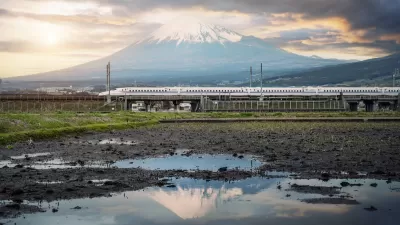Have high-speed rail stimulus funds put us any closer to technology like mag-lev? A long record of underfunding makes many of such projects shovel-unready, but hopes are still high.
"Competition for that $8 billion will be intense with big states like Illinois and New York promoting big plans. Nationwide, there are 11 high-speed-rail corridors in various stages of discussion, and one of them, a proposed 800-mile system that would run trains at speeds up to 220 mph and connect San Francisco, Los Angeles and San Diego, has already been jump started by a $10 billion bond issue approved by California voters in last November's election.
'California has a strong track record in conventional rail, and one reason the proposition was able to pass was what their tax dollars had done to improve the existing service,' said Ross Capon of the National Association of Rail Passengers. 'There's no question California is ahead of the pack with conventional rail and the voters' commitment to develop high-speed rail.'
'I think a lot of people will be watching to see how California goes, the challenges, the difficulties they run into,' added Jim Wrinn of Trains magazine. 'Once (high-speed rail) has been done outside the Northeast corridor (where the Boston-to-Washington Acela train tops out at 150 mph), I think a lot of people will jump into the pool.'"
FULL STORY: Stimulus Accelerates High-Speed Rail Hopes

Manufactured Crisis: Losing the Nation’s Largest Source of Unsubsidized Affordable Housing
Manufactured housing communities have long been an affordable housing option for millions of people living in the U.S., but that affordability is disappearing rapidly. How did we get here?

Americans May Be Stuck — But Why?
Americans are moving a lot less than they once did, and that is a problem. While Yoni Applebaum, in his highly-publicized article Stuck, gets the reasons badly wrong, it's still important to ask: why are we moving so much less than before?

Using Old Oil and Gas Wells for Green Energy Storage
Penn State researchers have found that repurposing abandoned oil and gas wells for geothermal-assisted compressed-air energy storage can boost efficiency, reduce environmental risks, and support clean energy and job transitions.

Greening Oakland’s School Grounds
With help from community partners like the Trust for Public Land, Oakland Unified School District is turning barren, asphalt-covered schoolyards into vibrant, green spaces that support outdoor learning, play, and student well-being.

California Governor Suspends CEQA Reviews for Utilities in Fire Areas
Utility restoration efforts in areas affected by the January wildfires in Los Angeles will be exempt from environmental regulations to speed up the rebuilding of essential infrastructure.

Native American Communities Prepare to Lead on Environmental Stewardship
In the face of federal threats to public lands and conservation efforts, indigenous groups continue to model nature-centered conservation efforts.
Urban Design for Planners 1: Software Tools
This six-course series explores essential urban design concepts using open source software and equips planners with the tools they need to participate fully in the urban design process.
Planning for Universal Design
Learn the tools for implementing Universal Design in planning regulations.
Heyer Gruel & Associates PA
City of Moreno Valley
Institute for Housing and Urban Development Studies (IHS)
City of Grandview
Harvard GSD Executive Education
Salt Lake City
NYU Wagner Graduate School of Public Service
City of Cambridge, Maryland





























